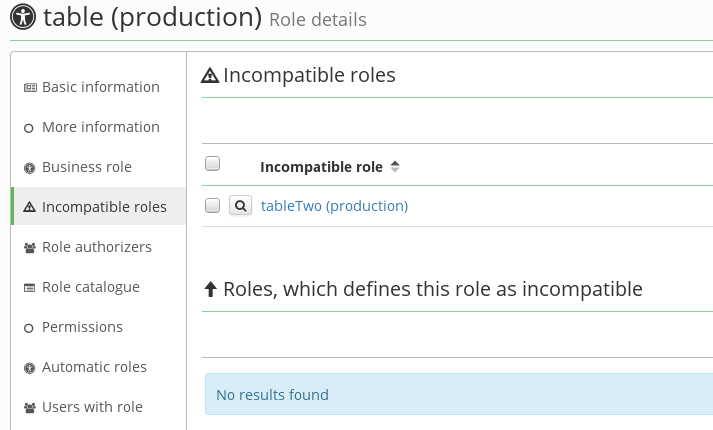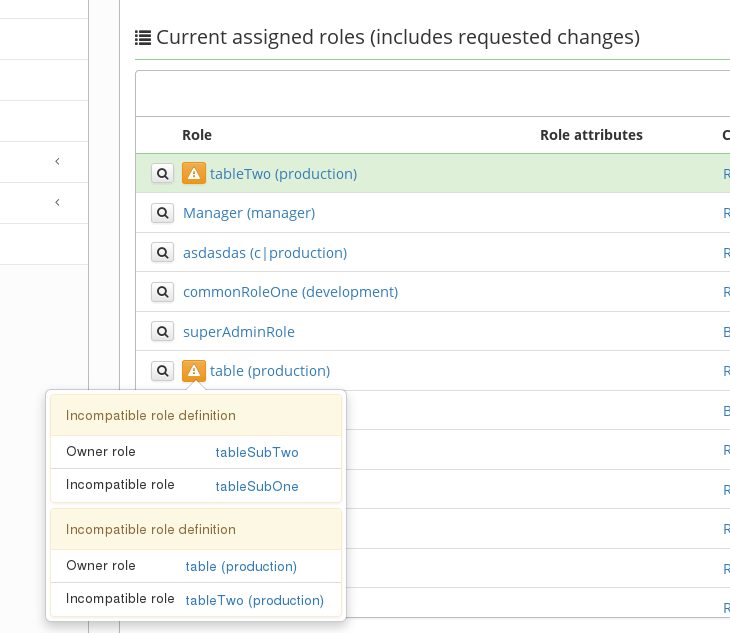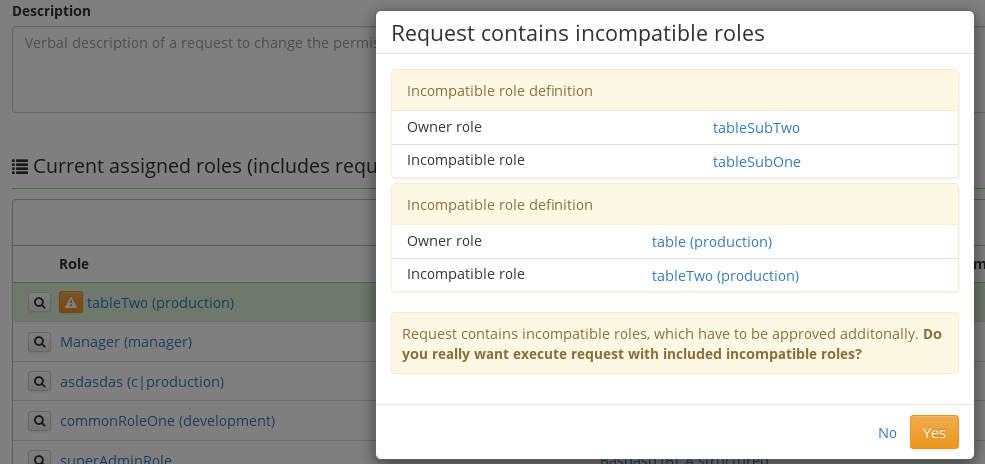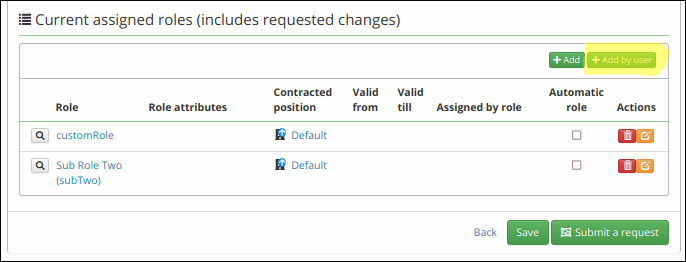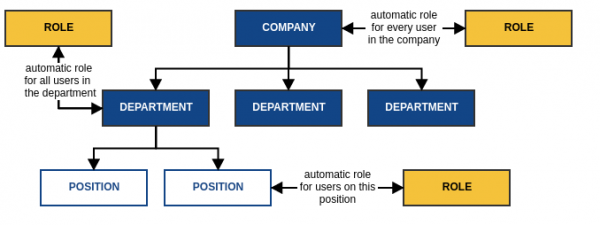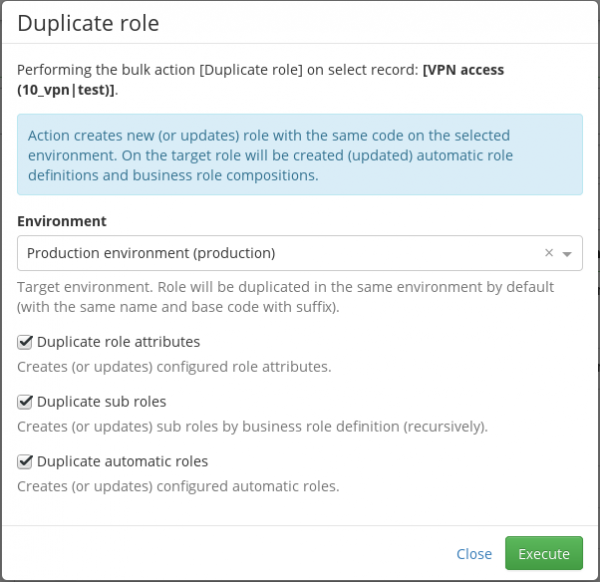This is an old revision of the document!
Roles
A role in CzechIdM is an entity representing a set (1 or many) of privileges on the end system or in CzechIdM itself (permission). Users acquire roles:
- automatically – according to the organizational placement of the identity, or identitie's attributes like adress or company.
- manually – through assigning based on the user’s request in the CzechIdM self-service or by a CzechIdM administrator.
Request for the role can be approved by specific user, usually helpdesk, user's manager or IT security.
Roes can be aggregated into business roles. Provided role A is a subrole of role B, If role B is assigned (no matter how - automatically or manually) to the user, he acquires also role A.
From the perspective of the identity manager, it does not matter whether the user acquires an account in a specific application, is placed in a group in LDAP, his indication is set to “can use VPN”, or permission is set for him in the application. In all the cases, a role is assigned. A simplification carried out like this allows general rules to be applied for assigning all types of permissions (~roles) in the same way.
Roles and contracts
Roles are assigned to users via their contracts. If a contract is not valid (time validity) the roles on the contract are removed. In other words, the identity loses roles permissions in IdM and rights in connected systems.
Roles and environment
Role with the same base code could be created from / for different environment. Final role code is combined from the base code and environment identifier. When role is created (or synchronized), then role attributes can be used:
baseCode- base code without environment. If environment is not used, thenbaseCodevalue is the same ascodevalue, e.g. roleOneenvironment- environment identifier, e.g. dev.code- complex code. If environment is not used, thenbaseCodevalue is the same ascodevalue, otherwise complex code is combined from base code, environment and joined with separator (|by default). For example roleOne|dev.
Role criticality
The level of criticality can be set for every role. Criticality denotes, who approves its assignment. Role can have criticality from 0 to 5.
Incompatible roles
Segregation of Duties (SoD) can be ensured by incompatible roles. Their setup resembles that of business roles, described above.
The old generation CzechIdM used to have a feature of Role's incompatibility. By incompatibility we mean that you can set restrictions on roles A and B that will stop any user or process from assigning these two roles to the same user at once. In the new generation CzechIdM, we now have a similar feature. The difference is, however, that our experience of CzechIdM deployments on projects have taught us that users prefer this incompatibility function to work merely as a soft mechanism. In other words, CzechIdM will allow a user (identity) to have incompatible roles as long as an administrator/security manager is notified about this incident. The security staff also get a new tool to generate a special report, listing all users with incompatible roles - the report is prepared in the reports module named Identities-assigned incompatible roles.
When an incompatible role has been assigned to an identity, a warning stating the incompatible role definition is shown.
Concurrence of incompatible roles and business roles
The same warning symbol is shown when an identity requests new role(s) which happen to be incompatible with one of the subroles nested within a business role composition. In this case, the informative symbol is ALSO shown next to a business role that IS NOT itself incompatible with the requested role.
In other words, the meaning of the symbol is somewhat different then: it does not mean the respective role - marked by this symbol - is incompatible, but rather it serves as an indication that one of the subroles down the business role cascade is incompatible.
Copying roles from a user
Copying roles from a user is a new feature that allows one user to easily copy roles/permissions from another user. You can get the same roles like one of your colleagues has by simply filing a request that admin then approves or declines. For more information please visit admin guide.
This feature is available in the role request detail, see the new button in the picture:
For more information about the feature with more detailed description, please see the admin guide.
Automatically assigned roles by organization structure
The role can be linked to a Tree structure (e.g. position in organizational structure). That role is assigned to and removed from a user based on adding/removing the user (via their contract or other contract position) to/from the organizational tree structure. If a contract is not valid yet, roles are assigned but are disabled until the contract starts.
Automatically assigned roles by attribute
The role can be also linked with value in attribute (value can be stored in Identity, Identity extended attribute, Contract and Contract extended attribute). That role is assigned to and removed from a user based on the value in the specific attribute. Recalculating of this automatic roles is done after saving identity, identity extended attribute attributes, contract and contract extended attribute attributes. All necessary attributes that defined automatic role by attribute are defined by agenda "Automatic role by attribute".
After save identity (save from identity detail) it will be done recalculation for all automatic roles that has at least one rule with type IDENTITY, recalculation from identity is done for all contracts for saved identity. After save contract extended attributes (save from extended attribute detail) it will be done recalculation for all automatic roles that has at least one rule with type CONTRACT_EAV.
Requests for change automatically assigned roles
Automatically assigned roles have a significant safety impact. When creating, editing, or deleting, it is necessary that the process is approved. For this purpose, an agenda for requests for change of automatic roles has been created.
This request gets the approval process from the criticality defined for that role. Critical role determines what process the application must accomplish to implement it.
Processes of defined by the role criticality is defined here. Processes for approval change of an automatic role are different then processes using for approving assign role to one user. For clarity, both processes (role assignment, change of the automatic role) are defined in one final process.
Duplicating roles
Role can be duplicated by prepared bulk action. Bulk action is available on the roles table.
Action provides features:
- Select environment - role will be duplicated to selected environment. If the same as role's environment is selected or environment input is leaved empty, the role is duplicated on the same environment with suffix added into role's base code, e.g. roleOne ⇒ roleOne_1. If the different environment is selected, then duplicate with the same base code is created (or updated).
- Duplicate role attributes - creates (or updates) configured role attributes.
- Duplicate sub roles - creates (or updates) sub roles by business role definition (recursively). If the same environment is selected, the only role composition is created - exists sub role is used. If the different environment (~target environment) is used, then sub roles with the same environment as original are duplicated recursively into target environment.
- Duplicate automatic roles - creates (or updates) configured automatic roles. Both automatic roles by the tree structure and by the attribute are duplicated.
Read more about action implementation and how it's possible to extend it.
Deduplicating roles
Since roles are assigned to a contract not to an identity, it may well happen that an identity ends up having some role duplicities. Partly, it may be due to the fact that role definitions are changed over time, and from a certain point on they start to be assigned in a different way (say, automatically). And one and the same identity may meet the updated condition as well, hence it gets the same role all over again.
Deduplication is a bulk action that is available on User agenda. Deduplication allows removing only manually added roles that are duplicite with another automatic role or another manually added role. More on this feature in the admin guide and tutorial.
Read more
Admin tutorials
- Deduplicating roles (to be completed)
Admin guide
- Copying and deduplicating assigned roles (to be completed)

